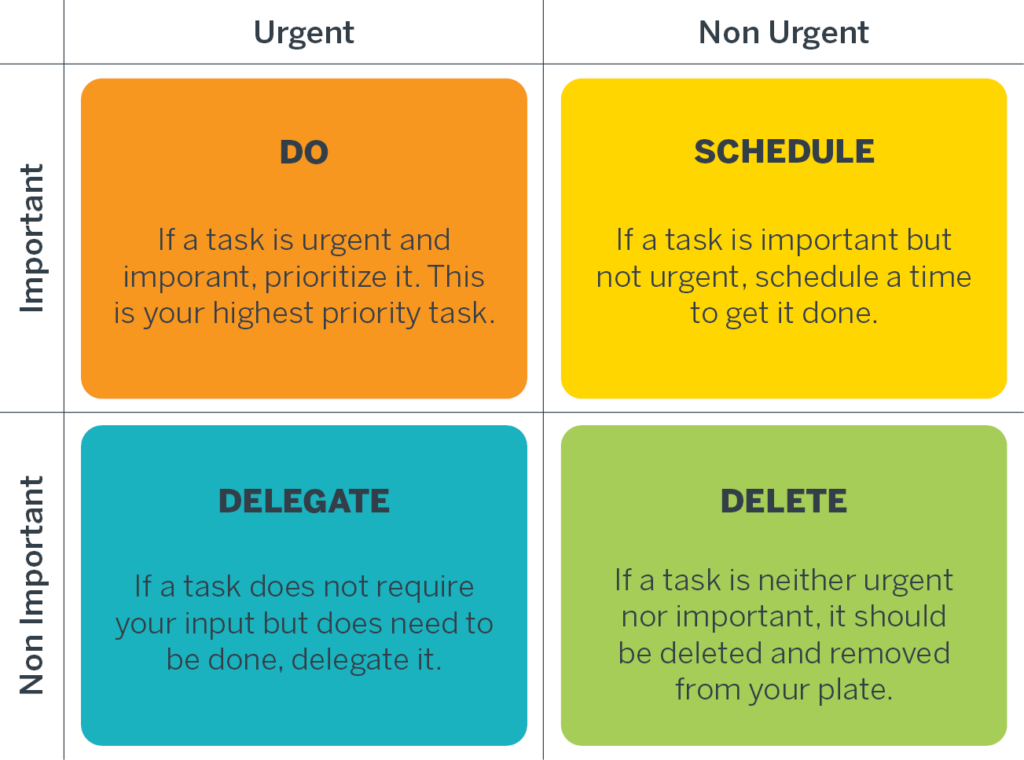By Anne Evenson

When you feel like you have an endless to-do list, it can be hard to feel accomplished at the end of the work day. Here are some tips to take control of your productivity and reduce stress.
“Setting clear guidelines for how you spend your time and energy is the easiest and most effective way to boost productivity.”
Slack’s Workforce Lab, research department for workplace improvement
How frustrating is it when you reach the end of your hectic workday only to realize that you’ve checked off a fraction of the tasks on your extensive to-do list? You had such high hopes when you started that morning, and now you wonder why you didn’t accomplish more.
Maintaining a consistent, high level of productivity can feel like a Sisyphean task, but you don’t have to lose control of your to-do list or succumb to the towering stack of papers on your desk. And you certainly shouldn’t feel disheartened and drained at the end of your workday, especially if you’ve made a real effort to get things done. Check out these tips and techniques to manage your time and energy better, upgrade your to-do list and take control of your productivity to feel more accomplished and less stressed.
Manage Your Energy
Your energy cycles directly affect your focus and work processes, so it’s critical to understand the ebbs and flows that occur naturally within your body and brain throughout the day. These peaks and valleys in your attention span and motivation are known as ultradian rhythms—your body’s biological cycles that occur multiple times every 24 hours. Physiological mechanisms like digestion, blood circulation, pulse, heart rate, hormone levels, thermoregulation, muscle tension and brain wave activity increase during the first phase of the cycle, elevating your alertness and cognition. After approximately 90 to 120 minutes, these measures begin to decline, and your body requires a period of rest and recovery.
So, instead of mercilessly pushing yourself from one task to another, try aligning your work routine with your natural rhythms. To achieve peak performance on most tasks, spend around 90 minutes working on them, followed by a 20-minute break. Journal to identify your biological prime times—optimal periods for deep focus, which are necessary for complex tasks that require more concentration. Save more menial tasks for when you feel depleted or foggy, like after lunch or towards the end of the day.
Upgrade Your To-Do List
Building your to-do list may seem like a relatively straightforward task that requires little forethought, but it’s not. Begin by recognizing that you can only accomplish a finite number of things daily. Don’t set yourself up for failure at the beginning of your day by having a to-do list that’s impossible to complete by the end of the day. Consider paring down the number of tasks by prioritizing five to ten things you’d like to make headway on that day. Or try the 1-3-5 rule: choose one large task, three medium tasks and five small tasks to complete on any given day.
If you need help prioritizing tasks, give the Eisenhower Matrix a go. This decision-making tool can help you distinguish between important, less important, urgent and non-urgent tasks. The Eisenhower Matrix can help you identify tasks you should:
Do: These important and urgent tasks have deadlines and consequences and must be executed today or tomorrow. An example could be your supervisor requesting that you review a time-sensitive document.
Schedule: These important but not urgent tasks have indefinite deadlines but still contribute to long-term success and can be added to your calendar. By leaving fewer items unplanned, you can reduce stress by pushing less urgent tasks to the near future.
Delegate: These less important but somewhat urgent tasks must be done, but not necessarily by you. For example, perhaps a colleague asks you for a pressing favor or requests that you join a meeting in progress. You could delegate this responsibility by recommending another person for the job or sending the required information to your colleague so they can handle the matter directly.
Delete: These are not important or urgent tasks you shouldn’t take on. Any tasks left over after you’ve reviewed your to-do list are usually distractions and bad habits that you should eliminate, or they will get in the way of accomplishing your goals. Some examples include scrolling through social media, playing games and aimlessly surfing the web.

Organize Your Tasks
Different tasks require different parts of your brain; for example, compiling a report based on data from various sources may differ from writing an article or responding to an email. Group similar tasks and do them in the same time block rather than switching back and forth, which can be mentally tiring. Many professionals assign specific times to answer emails so they can focus on other activities without interruption.
Shut Down Distractions
Distractions and interruptions impede productivity, and most fall into three categories: self-imposed (device notifications, the internet), environmental (visual or auditory distractions) and external (colleagues dropping by to chat, phone calls, delivery drivers).
To prevent self-imposed distractions, temporarily turn off work email notifications, set up an auto-response and switch your phone to vibrate or “do not disturb.” Avoid environmental distractions by wearing headphones, reducing your workspace clutter and repositioning your desk.
Practice Single-Tasking
Multitasking as a means of productivity is a myth. Research shows that the human brain cannot perform two tasks simultaneously. When we attempt to multitask, we lose roughly 20% of our overall productivity for each task we undertake concurrently. When you try to multitask, what’s really happening is called “task switching” or “context switching,” which is you interrupting yourself, which torpedoes your productivity.
Try stating your intention aloud to focus on one task at a time. For instance, “I’m going to edit this press release and send it back to my supervisor.” Psychologists call this “external self-talk,” studies show that it can enhance cognition and influence behavior. When you single-task, you’re much more likely to enter the “flow state,” a period of deep focus where you do meaningful and complex work at peak performance. In addition to feeling great, this magical flow makes you 500% more productive than when trying to multitask!
Free Yourself From Perfectionism
Perfection is unattainable, but that doesn’t stop some of us from frustrating the heck out of ourselves trying to achieve it. If you believe something must be completed perfectly but know that you can’t achieve flawlessness, then it’s easy not even to start a project or task. Perfectionism limits productivity by creating an infinite cycle of editing and tweaking, never allowing you to complete a task and move on to the next.
Refrain from obsessing over perfection by setting realistic time limits for each task. Avoid procrastination by concentrating on the process instead of the end product and breaking the task into smaller, more manageable chunks that you can focus on one at a time. And remember, not all mistakes are bad, and most are often growth opportunities.
The bottom line is that staying focused and motivated at work can be challenging. While aiming for peak performance every day is a stretch, there are many ways to increase your productivity without sacrificing your sanity and still feel accomplished and gratified at the end of your workday.

Anne Evenson is a native Austinite and a proud Veteran’s spouse with over 20 years of marketing, communications and program coordination experience in the public, private and nonprofit sectors. She is also a sculptor, jeweler and all-around dabbler in the arts and loves to help military-connected individuals discover their inner creativity.
Learning and professional growth go hand in hand. For regular career insights and information on continuing education programs offered by UT’s Center for Professional Education, subscribe to our monthly e-newsletter, It’s Your Career.
